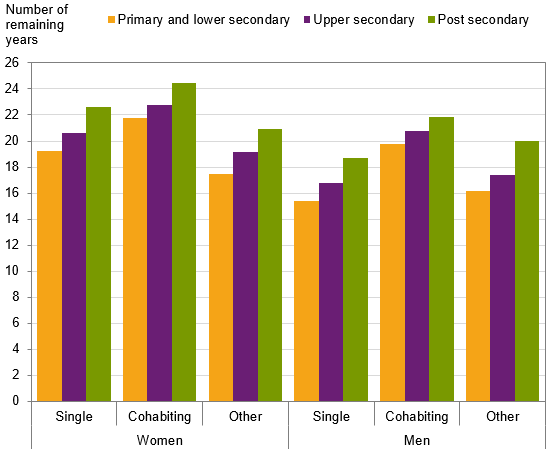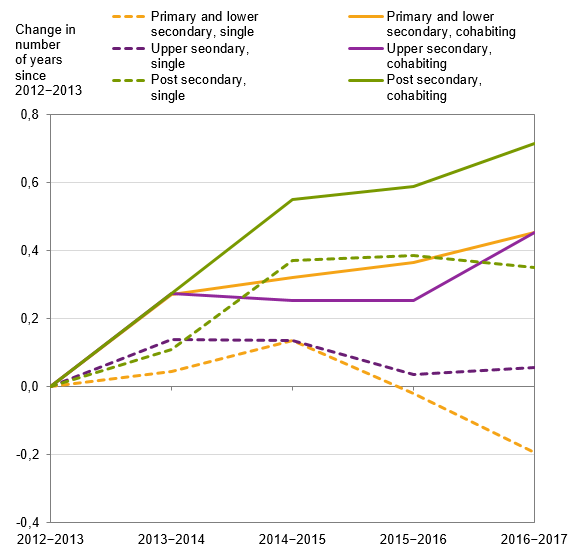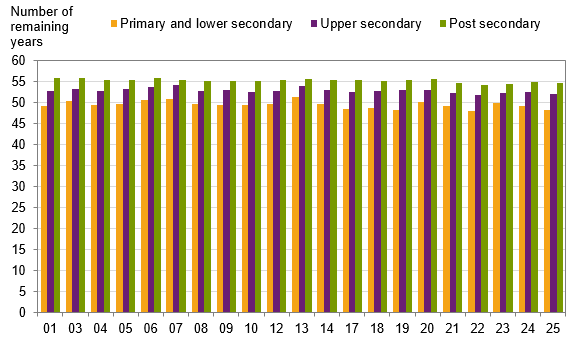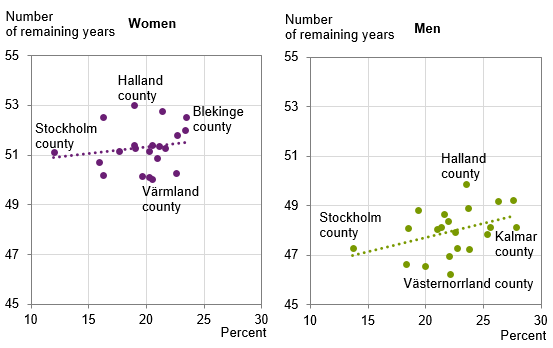Demographic analysis: Life tables by level of education
Average life expectancy increased most among highly educated persons
Statistical news from Statistics Sweden 2018-10-09 9.30
Between 2012 and 2017, remaining life expectancy at 30 years increased most in the group with post-secondary education. This increase was slightly less among those with a secondary education and least among those with compulsory education. The trend of growing gaps between groups with different education levels looks set to continue.
In 2017, the remaining average life expectancy at 30 years was 51.0 years among women and 48.3 years among men in the group with compulsory education. In the group with secondary education, remaining average life expectancy was 3.5 years higher, 54.5 years for women and 52.5 years for men. In the group with post-secondary education, remaining average life expectancy was 2.5 years higher than among those with secondary education, 57.0 years for women and 54.3 years for men. Between 2012 and 2017, average life expectancy at both 30 years and 65 years increased most among those with post-secondary education and the least among those with compulsory education. At 30 years, the gap between these groups has increased from 5.2 to 6.0 years for women and from 5.0 to 6.0 years for men.
| Education level | Women | Men | |||||
|---|---|---|---|---|---|---|---|
| 2012 | 2017 | Change | 2012 | 2017 | Change | ||
| At age 30 | |||||||
| Compulsory | 51.2 | 51.0 | ‑0.2 | 48.3 | 48.3 | 0.0 | |
| Upper secondary | 54.1 | 54.5 | 0.4 | 50.9 | 51.5 | 0.6 | |
| Post-secondary | 56.4 | 57.0 | 0.6 | 53.3 | 54.3 | 1.0 | |
| Total | 54.0 | 54.6 | 0.6 | 50.8 | 51.5 | 0.7 | |
| At age 65 | |||||||
| Compulsory | 20.2 | 20.3 | 0.1 | 17.7 | 18.1 | 0.4 | |
| Upper secondary | 21.3 | 21.5 | 0.2 | 18.7 | 19.3 | 0.6 | |
| Post-secondary | 22.9 | 23.3 | 0.4 | 20.2 | 20.9 | 0.7 | |
| Total | 21.0 | 21.5 | 0.5 | 18.5 | 19.2 | 0.7 | |
The statistics in the table refer to persons born in Sweden. Compulsory education level is equivalent to primary and lower secondary education.
Statistics Sweden has updated the statistics on remaining average life expectancy by level of education. Now, entire life tables are published, and more groups included in the report, such as foreign born persons, cohabiting persons and single persons. Life tables by education level are now also published in five-year periods by county.
Education least significant for cohabiting men
In recent years, it has been possible to calculate life expectancy by type of household. Living conditions can differ considerably between single persons and cohabiting persons, which, in turn, affects life expectancy in different ways depending on sex and education level.
There are clear differences in remaining average life expectancy at 65 years for women and men with different education level, independent of household type. Average life expectancy is also higher for cohabiting persons than for single persons and other households, in each one of the various education levels. Differences among education levels in remaining average life expectancy are smaller for cohabiting persons than for single persons and other households, for men in particular. Average life expectancy among cohabiting men with compulsory education is one year higher than among single men with post-secondary education.

The statistics in the figure refer to persons born in Sweden. Other households may include intergenerational households or multi-person households, such as elderly care homes. Other households make up nearly 6 percent of the mean population 65 years and over in 2017.
Life expectancy for single persons with no post-secondary education remained the same
At 65 years, differences in remaining average life expectancy are roughly the same or larger, by both education level and type of household, compared with differences between the sexes. Gaps between the sexes have narrowed over time, while gaps between groups with different education levels continue to widen. However, development among groups with different education levels vary depending on type of household. In the period 2012–2017, average life expectancy increased most for persons in the group with post-secondary education who were also cohabiting. During this period, average life expectancy also increased among those with secondary education and compulsory education who were also cohabiting. However, after 2014–2015, there is no visible increase in the number of years remaining in groups of persons who were single. Among single persons with a secondary education, the number of years remaining remained roughly the same in 2016–2017 as in 2012–2013, and among single persons with compulsory education the number of years remaining had even decreased slightly.

Both sexes together, two-year moving averages. The statistics in the figure refer to persons born in Sweden.
Recent years' changes point to growing social differences in the change in average life expectancy at 65 years. The group with the highest average life expectancy at 65 years in the beginning of the period 2012–2017, cohabiting, with post-secondary education, had the largest increase in average life expectancy, from 21.9 years to 22.7 years, while average life expectancy decreased in the group with the lowest average life expectancy from 17.8 years to 17.5 years. The gap between the groups with the highest and the groups with the lowest average life expectancy widened from 4.1 years in 2012 to 5.2 years in 2017.
Remaining average life expectancy at 30 years, by county and education level, 2013–2017
Differences in average life expectancy among education levels in all counties
For persons aged 30, there are differences in all counties in the number of remaining years of life expectancy among groups with different education levels. This applies similarly to both women and men. Figure 3 shows the two sexes together.

The statistics in the figure refer to persons born in Sweden. County legend: 01 Stockholm County, 03 Uppsala County, 04 Södermanland County, 05 Östergötland County, 06 Jönköping County, 07 Kronoberg County, 08 Kalmar County, 09 Gotland County, 10 Blekinge County, 12 Skåne County, 13 Halland County, 14 Västra Götaland County, 17 Värmland County, 18 Örebro County, 19 Västmanland County, 20 Dalarna County, 21 Gävleborg County, 22 Västernorrland County, 23 Jämtland County, 24 Västerbotten County, 25 Norrbotten County.

There is some variation in the number of remaining years of life expectancy at 30 years among counties. The variation between counties is largest in the group with compulsory education, slightly smaller among those with secondary education and least among those with post-secondary education. In the group with compulsory education, those living in Halland County had the highest number of remaining years, 51.3 years, and those living in Västernorrland County had the lowest number of remaining years, 47.9 years. Among those with secondary education, those living in Kronoberg County had the highest number of remaining years, 54.1 year, and those living in Västernorrland County had the lowest number of remaining years, 51.8 years. In the group with post-secondary education, the number of remaining years was highest in Jönköping County, 55.9 years. In this group, those living in Västernorrland County also had the lowest number of remaining years, 54.2 years.
Significance of diminished share of those with compulsory education unclear
A reason that is often cited with regard to growing gaps in remaining average life expectancy between groups with different educational levels, and in particular with regard to the group with compulsory education lagging behind groups with a higher level of education, is that the share of the population with no more than compulsory education is declining in all ages. This may mean that an increasingly large share of the group with compulsory education has poorer health. This can be checked by looking at the differences in remaining average life expectancy among counties in the group with compulsory education. A variation in average life expectancy between counties among those with compulsory education could then be explained by the size of the group's share compared with the county population. Relatively seen, the group with compulsory education would seem to have a higher average life expectancy in counties with a high share of those with compulsory education than in counties with a low share of those with compulsory education.
However, a comparison of counties' variation in the share of those with compulsory education and the number of remaining years at age 30 among those with compulsory education did not yield any link at all for women, and a weak link for men. This indicates that there are likely more factors, other than the size of the group in the population, which contribute to variation in average life expectancy in a group between counties and over time. Example of such factors are differences in behaviour, income, social networks, and outcomes of healthcare.
Definitions and explanations
Information about the quality of the statistics, production methods, and more is available on Statistics Sweden’s website. The life tables present all the data, such as average population, number of deaths, death risks, number of persons still living at various ages out of 100 000 persons aged 30 that make up the standard population in the calculation and the number of remaining years at various ages. There are three tables, with different study domains:
- Education level, region of birth (Sweden, abroad), sex, year and age
- Education level, type of household (single, cohabiting, other household), sex, year and age (defined to the population born in Sweden)
- Education level, county, sex, five-year period and age (defined to the population born in Sweden).
Statistical Database
More information is available in the Statistical Database
Feel free to use the facts from this statistical news but remember to state Source: Statistics Sweden.
